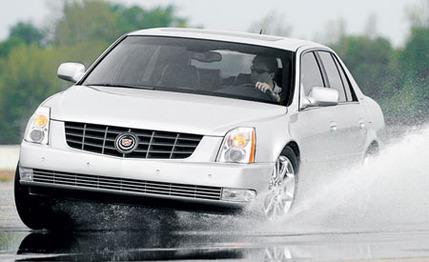
 Short Take Road Test
Short Take Road Test
Cadillac has updated its sole remaining front-drive car, the DeVille, the only Cadillac left from the old school of big cars for white-haired guys. The 2006 model has a sportier shape, a new interior, even a new name. It's now simply a DTS.
Not surprisingly, the DTS now sports Cadillac's revisionist signature grille and a degree of the current knife-edge styling seen on CTS and STS models. But the DTS is still pinned to the familiar G-platform, GM's front-drive, large-sedan structure that debuted on the then-new 2000 DeVille and is also used on the Buick Lucerne, a big front-drive GM sibling that invites comparison.
The DTS is mechanically identical to a V-8 Lucerne - both use the 4.6-liter Northstar engine and a four-speed automatic transmission - but the Cadillac is 4.4 inches longer and one inch wider. As a result, the DTS gets more back-seat room (55 cubic feet compared with the Buick's 51) and 19 cubic feet of trunk space, two more than in the Buick. But that size also contributes to the Cadillac's additional 212 pounds over the Buick's even two tons, so it can't quite keep up with the Lucerne. The DTS needs seven seconds to reach 60 mph and 15.4 seconds at 92 mph to cover the quarter-mile, 0.1 second off the Buick's pace in both tests ["Buick Lucerne CXS," C/D, March 2006].
Our test car was a "performance sedan" with the 1SE preferred-equipment option. That gets the buyer a small bump in horsepower, 291 instead of 275, and a small drop in torque, six pound-feet less than the usual 292. The 1SE also has a different shift algorithm and suspension tuning, although it doesn't make the DTS feel like what we would call a performance sedan. The car felt like the soft-riding Lucerne, and as noted earlier, it isn't any quicker. But for a car this large and nose heavy (over 60 percent of its weight rests on the front tires), its body motions seem well controlled. Even during a spirited, tire-squealing trip around an interstate on-ramp, the DTS takes a relatively flat set and maintains course. And although the bucket seats are about as supportive as a theater loge, you'll only manage 0.77 g of grip anyway, not enough to break the butt-to-leather-seat seal. Again, that grip level is respectable for a car of this nature but nothing we would label high performance. We were unable to measure skidpad grip for the Lucerne, but given that both cars came equipped with 18-inch wheels wrapped with Bridgestone Turanza EL400 touring tires, we'd expect similar results. That holds true for braking as well. Our test car needed 178 feet to stop from 70 mph, one foot more than the Buick.
A base DTS starts at $41,990. The 1SE version gets heated, cooled, and massaging power seats (providing a gentle pulse on your back); a heated steering wheel and washer fluid; and rain-sensing windshield wipers. Thus, to get the extra ponies - and the goodies - costs about $8500. Our test car also had a $1795 navigation system, a $1200 sunroof, $1200 "Tuscany" leather seats, $1000 adaptive cruise control, 18-inch chrome wheels for $795, a $350 power rear sunshade, and an engine-block heater for $100. It gets pricey - in fact, a wallet-busting $56,930, or almost $20,000 more than our Lucerne test car.
The DTS is the perfect choice for buyers looking for big Cadillac style and lots of gadgets. But we'd take a V-8 Lucerne and pocket 20 grand.